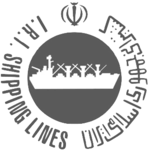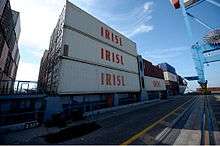IRISL Group
 | |
| Government owned | |
| Industry |
Shipping Shipyard |
| Founded | 1979 |
| Headquarters | Tehran, Iran |
Area served | Persian Gulf, Caspian Sea, Mediterranean Sea, Indian Ocean, Yellow Sea |
Key people | Mohammad Saeedi (Managing Director) |
| Website | www.irislgroup.com |
The maritime fleet of the Islamic Republic of Iran Shipping Lines (IRISL Group) comprises 115 ocean-going vessels, with the total capacity of 3.3 million tons deadweight (DWT). The ownership structure of the fleet comprises 87 ocean-going vessels in IRISL and 28 different types of ships under the flag of subsidiaries, including Khazar Shipping, Valfajr as well as Iran-India Shipping Companies. They are manned by 6,000 Iranian personnel including shore staff, masters, deck and engine officers as well as ratings, who work under the flag of the Islamic Republic of Iran in the Caspian Sea, Persian Gulf, international waters and various ports of the world.
IRISL has been sanctioned by the U.S., UN, EU and other parties for its role in advancing Iran's nuclear and ballistic missile programs. However, the return of the line to the world market was expected by early winter 2016, as a result of the Iran nuclear deal between Iran, the P5+1/EU3+3 powers, and the EU in August 2015.[1] IRISL has also announced its plans to become one of the world's top ten shipping lines by 2020.[2]
History
.jpg)
Due to the increase in the volume of imports into Iran since early 1960, consequence of which was to employ many foreign flag vessels to trade within Iranian ports caused some concerns to the country. In addition, the need and importance of a regular carriage of goods by sea and considering peculiar geographical characteristic, accessibility to open seas, with having had long water boundary and water ways to and from Iran made the necessity in initiating a research study to establish the first and biggest integrated national shipping lines. The result of the research study, which was started in 1961, was approved by the first general assembly meeting to establish Iranian National Shipping Company on August 1967 with the name of Aria Shipping Lines.
Aria Shipping started its activity in 1967 by two small-size vessels with capacity of 1,000 and 1,550 tonnes in Persian Gulf area and 4 ocean-going vessels, namely, Aria Sep, Aria Far, Aria Naz and Aria Gaam with the total capacity of 61,252 tonnes that had been put into service between the Persian Gulf-Europe, Asia and America. By the end of 1978 the number of Aria shipping vessels was 42, with the total capacity of 525,000 DWT, which proved the increasing of the sea transportation volume by Aria shipping lines and its effective role in Iran economy.
After the Islamic Revolution and change of economical and political policy on January 5, 1979, the authority renamed the Aria Shipping to Islamic Republic of Iran Shipping Lines (IRISL) and affiliated the company to the ministry of commerce.
During the Iran–Iraq War, numerous vessels such as Aria Boom, Aria Jahan, Aria Shaad, Aria Omid, became total losses due to missile attacks, as a result of which the IRISL suffered dearly. After this period, the names of all the vessels were changed to those of martyrs and cities with the prefix "IRAN".
However, since American sanctions (over Iran's support for various groups and nuclear program) have begun to hinder IRISL has taken to quickly renaming its ships under shell companies in order to continue trading in banned goods.[4] The sanctions are removed as a result of JCPOA deal with P5 +1 powers on lifting of nuclear sanctions against Iran, as of Winter 2016.[1]
Fleet

The International Maritime Organization has 140 member states with Iran ranking among the top 20. Iran plans to add 16 cargo ships to its naval fleet by mid-March 2010 to increase the total capacity to 5.8 million deadweight tons. The number of cargo ships in 2009 has reached 154, from 138 in 2008.[5] in 2011, It was the biggest fleet in the Middle East with about 170 vessels.[6]
The company has one of the biggest fleet in the world. It has 42 VLCC now.[7]
Ports and maritime organization
The Ports and shipping organization is a government agency under the authority of the Ministry of Roads and Transportation, with responsibility for supervising maritime trade and the operation of commercial ports and shipping in Iranian waters.
Marine transport is greatly dependent on auxiliary capacities and facilities including ports, roads, railroad and so on. Therefore, the port and shipping organization of Iran agreed to for operations of container terminals in Bandar Khorramshahr and Bandar Imam Khomeini to a subsidiary of IRISL (IRISL Port) in 2004. In addition, according to an agreement with the Islamic Republic of Iran Railways, a joint company was established to launch an express container line from southern Iranian ports to major destinations inside the country, as well as to CIS countries. These measures were in line with the long-term policy of the government to develop the transit sector and activate North-South Transit Corridor. All port terminals are currently run by private companies.
Development
Negotiations for building six 75,000 DWT Panamax bulk carriers and 10 Handymax bulk carriers with the capacity of 53,000 DWT have been finalized with Iran Shipbuilding & Offshore Industries Complex Co. (ISOICO) and SADRA shipyards respectively and if the prices are finalized, total value of contracts signed with domestic shipyards will surpass $600 million.

To support domestic industries, manufacturing containers inside the country has been encouraged. The first such contract, worth $10 million, was signed in 2001. It called for the production of 5,000 twenty-foot equivalent units (TEU) worth of containers and, so far, 1,600 containers have been delivered. As per IRISL's director, Iran needs to purchase or build 40 vessels by 2009. Over the next two decades, Iran would also need 500 new ships, including 120 oil tankers, 40 liquefied natural gas (LNG) carriers and over 300 commercial vessels.[8] In 2009, in a move aimed at further enhancing Iran's shipbuilding industry, President Mahmoud Ahmadinejad said he will ban the purchase of foreign ships by Iranian organizations.[9] Moreover, various kinds of industrial lubricants have been produced by Pars Oil Company as well as Behran Oil Company and, at present, about 70% of the lubricant needed by the fleet is supplied domestically.
In October 2006, a new company has been established in the southern port city of Bandar Abbas to repair various types of ocean liners. According to ISNA, the Bandar Abbas Pars Ship Repairing Company has been formed jointly by IRISL and ISOICO. The plant has the capacity to carry out maintenance works on large vessels with 500,000-ton capacity.[10]
In addition, profitability of the company has been on the rise despite elimination of state subsidies as a result of adopting a cost management, planned maintenance strategy, so that, the company’s net loss which amounted to $15 million in 1999 has been turned around to more than $150 million profits during the 2003–04 fiscal year. According to the article 44(C) of the Iranian Constitution, IRISL is ready for privatization.
International sanctions
IRISL is under sanctions by the United States, the United Nations, the European Union and other parties.
The United States implemented the first series of sanctions against IRISL in September 2008. Stuart Levey, the Under Secretary for Terrorism and Financial Intelligence, explained, "Not only does IRISL facilitate the transport of cargo for U.N. designated proliferators, it also falsifies documents and uses deceptive schemes to shroud its involvement in illicit commerce IRISL's actions are part of a broader pattern of deception and fabrication that Iran uses to advance its nuclear and missile programs. That conduct should give pause to any financial institution or business still choosing to deal with Iran."[11]
The UN followed with sanctions against IRISL in June 2010 as part of United Nations Security Council Resolution 1929.[12] The European Union implemented its own sanctions against IRISL a month later in July 2010.[13]
In 2012, the United States moved to clamp down on IRISL's use of deceptive front companies to shield its activities.[14]
See also
- Iran Shipbuilding & Offshore Industries Complex Co
- SADRA
- Transportation in Iran
- National Iranian Tanker Company
- Current Iranian Navy vessels
- International rankings of Iran
References
- 1 2 http://isna.ir/en/news/94051709740/Iran-shipping-line-to-be-removed-from-sanctions
- ↑ http://en.trend.az/iran/business/2432783.html
- ↑ http://en.mehrnews.com/news/120529/Iranian-shipping-line-s-global-ranking-jumps-to-19
- ↑ Trade by Iran Ships Is Veiled by Web of Shell Companies
- ↑ http://www.iran-daily.com/1388/3392/html/economy.htm
- ↑ Iran: Shipwrecked in Asia The Diplomat
- ↑ شرکت نفتکش ایران خود را «آماده بازگشت» به آبهای غرب میکند Radio Farda
- ↑ http://www.iran-daily.com/1388/3479/html/economy.htm
- ↑ http://www.presstv.ir/new/detail.aspx?id=104078§ionid=351020102
- ↑ http://www.iran-daily.com/1387/3310/html/economy.htm#s355461
- ↑ "Major Iranian Shipping Company Designated for Proliferation Activity". U.S. Treasury Department. 10 September 2008. Retrieved 4 May 2012.
- ↑ "Security Council Imposes Additional Sanctions on Iran, Voting 12 in Favour to 2 Against, with 1 Abstention". United Nations Security Council. 9 June 2010. Retrieved 4 May 2012.
- ↑ "Europe Imposes New Sanctions on Iran". The New York Times. 26 July 2010. Retrieved 4 May 2012.
- ↑ "U.S. Puts Clamps on Iranian Shipping Companies, Ships." MarineLink, July 13, 2012.
External links
- Official Website
- Iran Ports and Shipping Organization
- Iran Ports invest
- Maroos Shipping Company
- Iran Shipper Evades U.S. Blacklist - WSJ article about IRSL and sanctions against Iran
- Specialized reports
- BMI - Iran Shipping Report - 2010 (86-page report on Iran Shipping industry)
| Wikimedia Commons has media related to Islamic Republic of Iran Shipping Lines. |